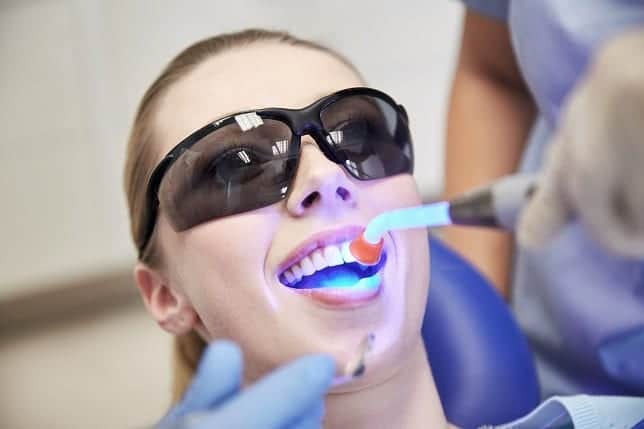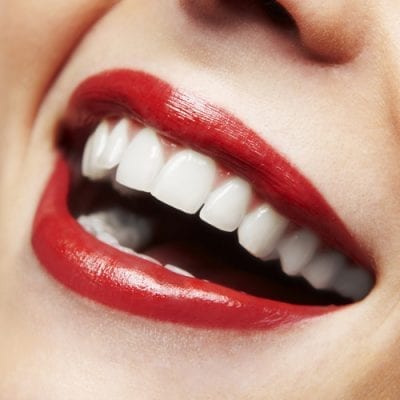It’s not surprising that people want only the best and most effective dental products possible for the maintenance and beautification of their teeth. That is why they’ll carefully choose everything – from their toothpaste to their dental floss and to their mouthwash – all in a bid to make sure that their teeth remain white and healthy.
While most people are already well-informed about choosing dental products that will keep their pearly whites healthy, there is scant attention given to choosing products that will keep people’s pearly whites – white. How should people choose teeth whitening or bleaching products? The brands and variants for such purpose are plenty.
This article will discuss the effectiveness of teeth whitening or bleaching and some of the most popular methods available for such. To begin with, it’s important to know that people have two major options for teeth whitening: at-home care and in-office teeth bleaching.
Page Contents
Why Whiten Your Teeth?

You should get your teeth whitened if you have yellowed, dull, or stained teeth to the point that you’re ashamed of showing off your smile. You should feel confident about your pearly whites. Therefore, it might be called for to use dental whitening products as a straightforward method of getting your smile confidence back when push comes to shove. This article is here to outline how these products work, particularly when it comes to the fact that it involves applying bleach solutions to teeth.
To be more specific, the bleach works by attacking the colored organic molecules lodged between the tooth enamel crystals that make it discolored. The enamel, meanwhile, is the tooth’s outermost covering that gives it its hardness and toughness. Below the enamel is the dentin or tooth material that fills in the rest of the tooth. At any rate, the organic particles give your teeth that stained or yellowing look, particularly when you haven’t brushed them for a long time.
Therefore, you should apply a peroxide-based bleaching solution on your teeth in order to restore them to their former white glory in a short period of time in case regular brushing isn’t doing you any favors.
What to Expect

At-home systems or bleaching kits usually use less peroxide than in-office systems. This is because the former are supposed to be safer due to their do-it-yourself nature and are usually usually applied for longer periods of time, similar to tooth brushing. Here are other important things to know about home teeth whitening or bleaching kits:
- Peroxide Percentages to Remember: To be more specific, at-home systems can contain as little as 3 percent and as much as 20 percent hydrogen or carbamide peroxide while clinic-based or in-office systems contain as little as 15 percent and as much as 43 percent peroxide.
- The Rule of Thumb: The rule of thumb of whitening is that the longer you keep the peroxide solution in your teeth, the white they will become. However, it comes with the catch that soaking your teeth in the solution for too long can result in enamel damage and teeth sensitivity. Furthermore, the higher the peroxide percentage, the shorter the time it should be applied.
- Dehydration and Sensitivity Concerns: Although safety measures have been implemented to make the peroxide bleaching agent milder now compared to how they were 10 to 20 years ago, you should still be wary as a patient when it comes to the length of time the gel is in your teeth because they’re proven to increase teeth sensitivity and can dehydrate teeth to unhealthy levels.
- Pros and Cons of Each Option: Talk to your dentist before trying out an at-home tooth-bleaching kit or applying for in-office laser whitening. He will discuss the benefits of a DIY program compared to a system where a professional can whiten your teeth in just one visit. You should also remember that these techniques could never whiten tooth-colored bondings and porcelain crowns.
Bleaching Kits at Home
Here’s the information you’re specifically hunting for. This article covers everything you need to know about at-hoe teeth bleaching options and its many choices out there. The most common of them include the following:
- Tooth Whitening Toothpastes: Yes, this is considered an at-home bleaching kit in a sense. They work the same way facial creams with exfoliator beads do. This toothpaste is mildly abrasive and can assist in the removal of stains from your enamel. It also contains polishing agents or chemicals that assist in scrubbing stains away from our teeth without bleaching agent support.
Such toothpastes are cheap and can brighten your teeth by about one shade. The downside to them is that their results aren’t as dramatic as peroxide-based bleaching kits, although there are special whitening toothpastes that contain peroxides. Then again, you can’t leave those toothpastes in your mouth anyway, thus lowering their effectiveness when push comes to shove.
- Whitening Strips and Gels: Peroxide-based whitening strips and gels for your teeth are typically applied directly unto the teeth enamel. You usually have to use a thin strip or brush to apply the gel. Such bleaching products typically require a regular application of one or twice daily for 10 to 14 days or more than a week to two weeks. They soak the teeth in peroxide pretty much the same way as tray-based systems.
Whitening strips are covered in bleaching gel and made of thin, flexible membranes that you put unto the teeth themselves. They’re made to conform to teeth shape, making them quite convenient and effortless to use. You won’t have to mix the gel or do molds of your teeth to use them. Furthermore, they’re unobtrusive enough to be worn while you’re working in your office, shopping at the grocery, or commuting to and from your workplace.
This method of bleaching costs from $10 at the cheapest to $55 at the most expensive and it can product results that last four or more months. It’s also available in most drugstores and specialty dental stores as an over-the-counter or OTC type of product. You can even order them online or have your dentist hook you up with a supplier if you wish to really avail of them at a discount.
For a three-week supply of 84 strips in one box, it costs about $50, but you can get them as cheap as $20 to $45 OTC. The most popular brand of dental whitening strips is Crest Whitestrips Supreme, which contains 14 percent of peroxide. This is the highest dose available for strips and thusly is available at dentist clinics and officers. These strips are big enough to cover up to six of your teeth, so you need more than a couple to cover your entire mouth.

Just remember that when compared to tray-based tooth bleaching systems, these strips are less effective when removing stains that are in between each tooth. They’re also not recommended for use by those with crooked teeth. What’s more, saliva can easily get into the strips and dilute the bleaching gel, making them less potent than before. If you have an extra wide smile, you might have strips too short to cover it and they tend to slip and slide inside your mouth too.
- Brush-On Whiteners: There are also foam-tip or brush-on pen applicators available in the market to date that you can use for fuss-free instant whitening. The beauty with these whitening pens is that they can be used directly unto your teeth after meals or after you’ve brushed your teeth, allowing you to forego the use of strips and trays with a more direct approach to teeth whitening.
These pens have been called instant “antidotes” compared to stains from food and drinks like red wine. They should be used after eating as well. They’re better than strips and trays because they get painted on. However, certain dentists frown upon them because they’re viewed as less effective. It’s also harder to keep the whiteness consistent or completely even when painting the bleaching over individual teeth.
- Tray-Based Tooth Bleaching Systems: This is the teeth-whitening option where a mouthguard-like tray is filled with peroxide-based paste or gel before being placed on your teeth for several hours a day for around four weeks or a month, with them really soaking your enamel until it becomes white. The idea here is to let the bleach work its way unto your teeth for lengthy periods of time.
This tray-based treatment with custom-fitted mouthguards that serve as the tray for the bleach also protects your gums from having the bleach dribble unto them, which should then cause irritation. The whitening compounds are either stored in syringes for adding into the tray or preloaded into the trays themselves prior to usage. In a lot of cases, the dentist can fine-tune the peroxide concentration, adding a desensitizing agent before or after applying the tray.
Tray-based solutions are better than strips because they remove saliva from the equation. More to the point, they ensure a maximum bleaching effect because they’re designed in a way that ensures the bleach stays in contact with your teeth enamel compared to strips that might get watered down by your spit, tongue, or mouth movement, thus diluting the strength of the peroxide whitener in question. Usually, the kits offer enough gel for a two-week-long single treatment annually. You can also do one-day or two-day touchups every 4-6 months.
This dental whitening technique works like how some housewives clean the bathroom tiles by leaving it soaked in bleach for about an hour or more before it is rinsed. However, like with tiles, you should be careful in abusing and overusing these peroxide soaks because it could lead to the weakening your enamel and increased possibility of tooth sensitivity to pain and temperature changes. You can have it custom-fitted by your dentist or avail of it OTC. It costs about $150 to $600.
Keeping Teeth White
Whether you’re using at-home dental bleaching systems or in-office ones, you can help maintain the results by positive dental hygiene habits like brushing, flossing, and using mouthwash on a daily basis. You can also do preventive maintenance by avoiding foods, drinks, and substances that could stain your teeth to off-white or yellowish colors. You should specifically avoid tannin-rich or acidic foodstuffs and beverages like the following:
- Sports drinks
- White and red wine
- Black teas and coffee
- Sauces (soy, tomato, and curries)
- Berries and other strong-colored foods
- Carbonated beverages (dark and light-colored sodas)
Why You Should Talk to Your Dentist
As discussed above, your teeth can become temporarily or permanently sensitive after undergoing tooth bleaching depending on the healthiness of your teeth and the concentration of peroxide used. Incorrect usage can even lead to gum burns or even temporary gum bleaching.
- Brown Teeth versus Yellow Teeth: Bleaching of teeth enamel best works on yellowed teeth with stains from food instead of brown teeth that requires stronger bleaching and peroxide percentages.
- Purple and Gray Teeth: Teeth that have become gray or purple because the dentin was affected cannot be dealt with through cosmetic tooth bleaching at all. This is because the discoloration affects more than just the enamel. There’s also a possibility that the graying tooth is already dead.
- Dental Consultation Is Important: Always consult with your dentist for more details. He will tell you whether or not it’s worth your time or money to look for and buy these whitening kits or if it’s instead better to avail of dentures, crowns, jackets, or veneers.
In a Nutshell

If you’re searching for an alternative to dental office professional bleaching that even though takes only a visit or two has greater risk in increasing your teeth sensitivity, then bleaching kits you can use at home like your toothbrush and toothpaste might be called for. DIY solutions are available by the dozens, whether they’re sold on the Internet, bought OTC at stores, or professionally dispensed by dentists. Some ready-to-use whiteners are already pre-mixed for your convenience. Others require mixing at home but come at a cheaper price if you lack a budget.
If you wish for a brighter smile and feel dissatisfied with merely brushing your teeth yet still lacking the smile brightness you desire, then you should look into bleaching your teeth. Teeth whitening or bleaching options all use peroxide-based bleaching agents to some degree, some more than others. You need to be careful about such agents though because they’ve been known to cause teeth sensitivity, although measures have been implemented to ensure that there is more bleaching action and fewer issues regarding bleaching side effects.
Thantakit International Dental Center is Thailand’s longest established dental center. Situated in Bangkok, our clinic is renowned across the world as a destination for world-class dentistry, with most of our patients flying to us from Australia.
Please contact us today and get a FREE dental consultation.












